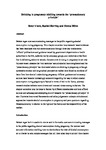Drinking in pregnancy: shifting towards the 'precautionary principle'
| dc.contributor.author | Milne, Emma | |
| dc.contributor.author | Thom, B | |
| dc.contributor.author | Herring, R | |
| dc.contributor.editor | MacGregor S | |
| dc.contributor.editor | Thom B | |
| dc.date.accessioned | 2020-03-04T12:40:50Z | |
| dc.date.issued | 2020-02-21 | |
| dc.identifier.isbn | 9781138491243 | |
| dc.identifier.other | 5 | |
| dc.identifier.uri | http://hdl.handle.net/10026.1/15430 | |
| dc.description.abstract |
Debate rages over communicating messages to the public regarding alcohol consumption during pregnancy. This chapter considers how research-based evidence has been translated into risk communications through three key mechanisms: ‘official’ publications and guidance issued by government departments or health authorities in the UK; websites run by advocacy groups; and midwives at the front line in delivering advice to women. Concern over drinking in pregnancy is not new but over recent decades the ‘risk narrative’ around alcohol has strengthened and the ‘precautionary principle’ has dominated advice on drinking in pregnancy, although systematic reviews and longitudinal prospective studies have found no evidence of harm from low alcohol intake during pregnancy. Official guidance and advocacy sources have become increasingly consistent regarding the way in which alcohol consumption during pregnancy is framed in terms of risk to the foetus, whereas research studies indicate more diverse and nuanced views among midwives. The chapter considers how the issue is framed by different stakeholders and how official sources and advocacy are attempting to shift towards the ‘precautionary principle’. It also illustrates how moral frameworks and value judgements underpin attitudes and approaches towards alcohol consumption in pregnancy and pose questions regarding female autonomy in relation to the rights of the foetus and the responsibility of the mother. | |
| dc.format.extent | 66-87 | |
| dc.language.iso | en | |
| dc.publisher | Routledge | |
| dc.relation.ispartof | Risk and Substance Use: Framing Dangerous People and Dangerous Places | |
| dc.rights | Attribution-NonCommercial-NoDerivatives 4.0 International | |
| dc.rights | Attribution-NonCommercial-NoDerivatives 4.0 International | |
| dc.rights | Attribution-NonCommercial-NoDerivatives 4.0 International | |
| dc.rights | Attribution-NonCommercial-NoDerivatives 4.0 International | |
| dc.rights | Attribution-NonCommercial-NoDerivatives 4.0 International | |
| dc.rights.uri | http://creativecommons.org/licenses/by-nc-nd/4.0/ | |
| dc.rights.uri | http://creativecommons.org/licenses/by-nc-nd/4.0/ | |
| dc.rights.uri | http://creativecommons.org/licenses/by-nc-nd/4.0/ | |
| dc.rights.uri | http://creativecommons.org/licenses/by-nc-nd/4.0/ | |
| dc.rights.uri | http://creativecommons.org/licenses/by-nc-nd/4.0/ | |
| dc.subject | Substance Misuse | |
| dc.title | Drinking in pregnancy: shifting towards the 'precautionary principle' | |
| dc.type | chapter | |
| plymouth.publisher-url | https://www.crcpress.com/Risk-and-Substance-Use-Framing-Dangerous-People-and-Dangerous-Places/MacGregor-Thom/p/book/9781138491243 | |
| plymouth.publication-status | Published online | |
| dc.identifier.doi | 10.4324/9781351033503 | |
| plymouth.organisational-group | /Plymouth | |
| plymouth.organisational-group | /Plymouth/Faculty of Arts, Humanities and Business | |
| plymouth.organisational-group | /Plymouth/REF 2021 Researchers by UoA | |
| plymouth.organisational-group | /Plymouth/REF 2021 Researchers by UoA/UoA18 Law | |
| dc.publisher.place | Abingdon | |
| dc.rights.embargodate | 2021-8-21 | |
| dc.rights.embargoperiod | Not known | |
| rioxxterms.versionofrecord | 10.4324/9781351033503 | |
| rioxxterms.licenseref.uri | http://creativecommons.org/licenses/by-nc-nd/4.0/ | |
| rioxxterms.type | Book chapter |



